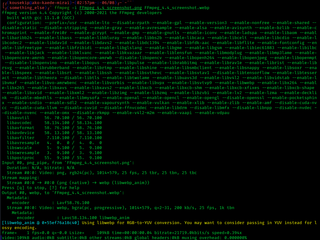MPEG-1 is a standard for lossy compression of video and audio. It is designed to compress VHS-quality raw digital video and CD audio down to about 1.5 Mbit/s without excessive quality loss, making video CDs, digital cable/satellite TV and digital audio broadcasting (DAB) practical.
Windows Media Audio (WMA) is a series of audio codecs and their corresponding audio coding formats developed by Microsoft. It is a proprietary technology that forms part of the Windows Media framework. WMA consists of four distinct codecs. The original WMA codec, known simply as WMA, was conceived as a competitor to the popular MP3 and RealAudio codecs. WMA Pro, a newer and more advanced codec, supports multichannel and high resolution audio. A lossless codec, WMA Lossless, compresses audio data without loss of audio fidelity. WMA Voice, targeted at voice content, applies compression using a range of low bit rates. Microsoft has also developed a digital container format called Advanced Systems Format to store audio encoded by WMA.
Adaptive Transform Acoustic Coding (ATRAC) is a family of proprietary audio compression algorithms developed by Sony. MiniDisc was the first commercial product to incorporate ATRAC in 1992. ATRAC allowed a relatively small disc like MiniDisc to have the same running time as CD while storing audio information with minimal loss in perceptible quality. Improvements to the codec in the form of ATRAC3, ATRAC3plus, and ATRAC Advanced Lossless followed in 1999, 2002, and 2006 respectively.

Sony Dynamic Digital Sound is a cinema sound system developed by Sony, in which compressed digital sound information is recorded on both outer edges of the 35 mm film release print. The system supports up to eight independent channels of sound: five front channels, two surround channels and a single sub-bass channel. The eight channel arrangement is similar to large format film magnetic sound formats such as Cinerama and Cinemiracle. The five front channels are useful for very large cinema auditoriums where the angular distance between center and left/right channels may be considerable. SDDS decoders provide the ability to downmix to fewer channels if required.
Dolby Digital, originally synonymous with Dolby AC-3, is the name for what has now become a family of audio compression technologies developed by Dolby Laboratories. Formerly named Dolby Stereo Digital until 1995, the audio compression is lossy, based on the modified discrete cosine transform (MDCT) algorithm. The first use of Dolby Digital was to provide digital sound in cinemas from 35 mm film prints; today, it is now also used for applications such as TV broadcast, radio broadcast via satellite, digital video streaming, DVDs, Blu-ray discs and game consoles.

FFmpeg is a free and open-source software project consisting of a suite of libraries and programs for handling video, audio, and other multimedia files and streams. At its core is the command-line ffmpeg tool itself, designed for processing of video and audio files. It is widely used for format transcoding, basic editing, video scaling, video post-production effects and standards compliance.

DVD-Audio is a digital format for delivering high-fidelity audio content on a DVD. DVD-Audio uses most of the storage on the disc for high-quality audio and is not intended to be a video delivery format.
Advanced Audio Coding (AAC) is an audio coding standard for lossy digital audio compression. Designed to be the successor of the MP3 format, AAC generally achieves higher sound quality than MP3 encoders at the same bit rate.
Dolby Pro Logic is a surround sound processing technology developed by Dolby Laboratories, designed to decode soundtracks encoded with Dolby Surround.

Dolby Laboratories, Inc. is an American company specializing in audio noise reduction, audio encoding/compression, spatial audio, and HDR imaging. Dolby licenses its technologies to consumer electronics manufacturers.

DTS, Inc. is an American company that makes multichannel audio technologies for film and video. Based in Calabasas, California, the company introduced its DTS technology in 1993 as a competitor to Dolby Laboratories, incorporating DTS in the film Jurassic Park (1993). The DTS product is used in surround sound formats for both commercial/theatrical and consumer-grade applications. It was known as The Digital Experience until 1995. DTS licenses its technologies to consumer electronics manufacturers.
Dolby Digital Plus, also known as Enhanced AC-3 is a digital audio compression scheme developed by Dolby Labs for transport and storage of multi-channel digital audio. It is a successor to Dolby Digital (AC-3), also developed by Dolby, and has a number of improvements including support for a wider range of data rates, increased channel count and multi-program support, and additional tools (algorithms) for representing compressed data and counteracting artifacts. While Dolby Digital (AC-3) supports up to five full-bandwidth audio channels at a maximum bitrate of 640 kbit/s, E-AC-3 supports up to 15 full-bandwidth audio channels at a maximum bitrate of 6.144 Mbit/s.
Dolby TrueHD is a lossless, multi-channel audio codec developed by Dolby Laboratories for home video, used principally in Blu-ray Disc and compatible hardware. Dolby TrueHD, along with Dolby Digital Plus (E-AC-3) and Dolby AC-4, is one of the intended successors to the Dolby Digital (AC-3) lossy surround format. Dolby TrueHD competes with DTS's DTS-HD Master Audio, another lossless surround sound codec.
Cinema Digital Sound (CDS) was a multi-channel surround sound format used for theatrical films in the early 1990s. The system was developed by Eastman Kodak and Optical Radiation Corporation. CDS was quickly superseded by Digital Theatre Systems (DTS) and Dolby Digital formats.

DTS-HD Master Audio is a multi-channel, lossless audio codec developed by DTS as an extension of the lossy DTS Coherent Acoustics codec. Rather than being an entirely new coding mechanism, DTS-HD MA encodes an audio master in lossy DTS first, then stores a concurrent stream of supplementary data representing whatever the DTS encoder discarded. This gives DTS-HD MA a lossy "core" able to be played back by devices that cannot decode the more complex lossless audio. DTS-HD MA's primary application is audio storage and playback for Blu-ray Disc media; it competes in this respect with Dolby TrueHD, another lossless surround format. DTS-HD MA has enjoyed the greater share of this market since 2010, with the notable exception of the TrueHD-encoded Dolby Atmos spatial surround format, which is more popular than DTS's competing DTS:X.
MPEG Surround, also known as Spatial Audio Coding (SAC) is a lossy compression format for surround sound that provides a method for extending mono or stereo audio services to multi-channel audio in a backwards compatible fashion. The total bit rates used for the core and the MPEG Surround data are typically only slightly higher than the bit rates used for coding of the core. MPEG Surround adds a side-information stream to the core bit stream, containing spatial image data. Legacy stereo playback systems will ignore this side-information while players supporting MPEG Surround decoding will output the reconstructed multi-channel audio.
SBC, or low-complexity subband codec, is an audio subband codec specified by the Bluetooth Special Interest Group (SIG) for the Advanced Audio Distribution Profile (A2DP). SBC is a digital audio encoder and decoder used to transfer data to Bluetooth audio output devices like headphones or loudspeakers. It can also be used on the Internet. It was designed with Bluetooth bandwidth limitations and processing power in mind to obtain a reasonably good audio quality at medium bit rates with low computational complexity. As of A2DP version 1.3, the Low Complexity Subband Coding remains the default codec and its implementation is mandatory for devices supporting that profile, but vendors are free to add their own codecs to match their needs.

aptX is a family of proprietary audio codec compression algorithms owned by Qualcomm, with a heavy emphasis on wireless audio applications.
Dolby AC-4 is an audio compression technology developed by Dolby Laboratories. Dolby AC-4 bitstreams can contain audio channels and/or audio objects. Dolby AC-4 has been adopted by the DVB project and standardized by the ETSI.







